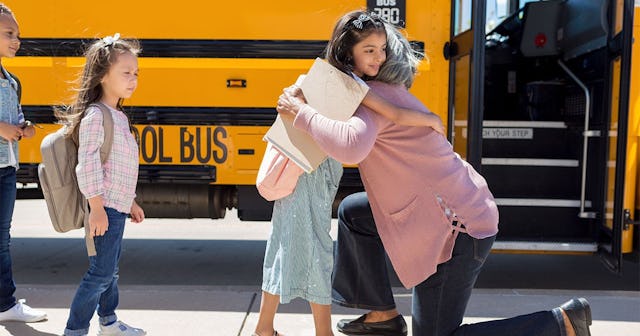You Can Literally Teach Kids To Not Be A-Holes

Empathy. You either have it or you don’t, right? Like a creative bone, blue eyes, or dimples genetically predisposed to form the craters in one’s cheeks…
Except not really.
Because while some of us are more biologically inclined to possess stronger empathetic attributes, empathy is actually a learned, evolutionary response. Because of empathy, our ancestors were able to help one another thrive in large groups. Where one family struggled with food, shelter, or health, another one could step in and provide what was lacking. Lifting the weight off of one another is how the well-rounded communities we live in today were first formed.
But it seems empathetic souls are of a dying breed in the 21st century amongst most first-world countries. In the United States, we are lacking a sense of community care grounded in empathy. Because when it comes to our immediate needs (food, water, shelter, etc.), we’ve evolved into a self-sustainable position throughout the ages. We value individualism and continue to perpetuate the “bootstraps myth.”
But in Denmark, a nation deemed “the happiest place in the world,” empathy is considered such an important tool that’s fostered in young people — in school and out of school — so they can grow into caring adults.
MoMo Productions/Getty
Starting as young as preschool, Danish schools’ curriculum mandates that one hour of the school day be dedicated to teaching empathy. During this hour, known as “Klassenstime,” students focus on solving the everyday problems that are too big for one child, or one group of children, to tackle on their own. Together, students and teachers work on problem-solving techniques and gain a better understanding of one another’s struggles, which ultimately gives the children feelings of support and unity. Sometimes, students even bake and eat a cake together during their moments of sharing to create a more family-like, safe setting. And when there aren’t at-home or in-school problems needing to be discussed, this hour is spent relaxing and finding ways to connect with classmates on an intimate level.
Emphasis on competing with one another isn’t essential to the Danish school system’s curriculum in the same way it is to Americans either. There are no trophies, ribbons, or prizes for “beating” other classmates. Rather, the focus is on motivation and bettering one’s self by using teamwork to reach and surpass students’ inner-expectations. Instead of putting educationally gifted children together and segregating the children who are gifted in other ways, Denmark’s children aren’t separated based on learning abilities. In doing this, the hope is that “high-ability” students would be able to help their peers exceed their educational goals, while also showing empathy for the struggles of their fellow classmates.
“Empathy is very important for democracy,” Mette Løvbjerg, headmaster at Møllevang in Faxe, told The Christian Science Monitor. “You can’t have a democracy that is functioning if nobody puts themselves in another one’s shoes…. If we don’t teach our children that, then we don’t have a democracy in 50 years. It’s under pressure already.”
Nobody wants to feel lonely, unheard, or unseen in their problems, let alone, a child. While some adults may find the hardships of a child as too “trivial” for the system to tend to by carving an hour-long chunk out of an 8-hour school day, these child-like problems only grow in intensity with age, creating more severe consequences to ignored struggles. The bullying becomes more frequent. The mental illness festers. And the suicide and school-shooting rates sky-rocket… as we’ve already seen and continue to see in America’s ever-booming school shooting statistics today.
Empathy is considered such an important tool that’s fostered in young people — in school and out of school — so they can grow into caring adults.
Parents are fearful to send their children to school because of the past and all-too-recent, horrifying news headlines, and we are also seeing an increase in teen suicide.
SDI Productions/Getty
Although America has implemented certain programs in some states to help children better identify and work through not only their own feelings, but those of others, we still have mountains to move if we are to resemble the empathetic culture like those of “the happiest people in the world.”
We’ve yet to follow in the Danish school system’s footsteps when teaching our children empathy, and we’ve forgotten that empathy is the foundation on which the human race thrives.
“Human beings are born with the capacity for kindness and compassion; however, that capacity has to be nurtured to be fully realized. People in whom it is nurtured are better equipped to live meaningful and productive lives,” lead author Carol Tomlinson, Professor and Chair of Educational Leadership, Foundations, and Policy at the University of Virginia’s Curry School of Education, wrote in her publication of The Empathetic School. “Working together as teachers, leaders, and students to build an environment that embodies compassion and empathy stretches all of us. It extends our possibilities. It satisfies a profoundly fundamental need.”
Sometimes all it takes is one single act of kindness from another, one person in tune with someone else’s feelings other than their own, for great change and hope to be formed in an otherwise hopeless individual. Similar to how empathy sustained family blood lines and communities for hundreds of generations, compassionate behaviors aren’t easily forgotten. And often times, they are reciprocated to benefit another mirroring their then-self.
When empathy exists, it brings with it a continuous ripple effect. One that sparks individuals to engage in behavior that benefits others through acts of altruism and heroism. By empowering students with support, understanding and an overall sense of community throughout the school day, we would be changing the way an entire generation of kids views their peers.
We would literally be helping the world to continue going ’round.
This article was originally published on